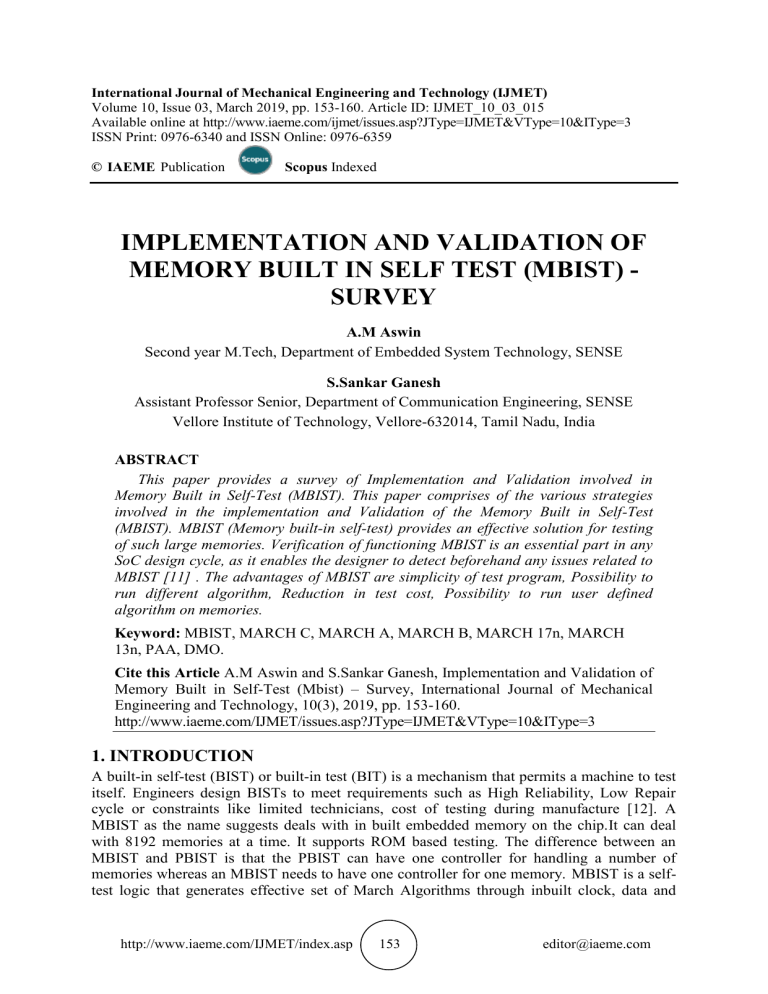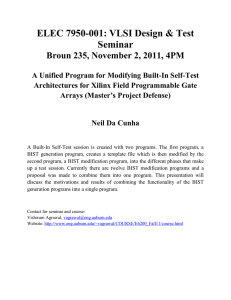IMPLEMENTATION AND VALIDATION OF MEMORY BUILT IN SELF TEST (MBIST) - SURVEY
advertisement

International Journal of Mechanical Engineering and Technology (IJMET) Volume 10, Issue 03, March 2019, pp. 153-160. Article ID: IJMET_10_03_015 Available online at http://www.iaeme.com/ijmet/issues.asp?JType=IJMET&VType=10&IType=3 ISSN Print: 0976-6340 and ISSN Online: 0976-6359 © IAEME Publication Scopus Indexed IMPLEMENTATION AND VALIDATION OF MEMORY BUILT IN SELF TEST (MBIST) SURVEY A.M Aswin Second year M.Tech, Department of Embedded System Technology, SENSE S.Sankar Ganesh Assistant Professor Senior, Department of Communication Engineering, SENSE Vellore Institute of Technology, Vellore-632014, Tamil Nadu, India ABSTRACT This paper provides a survey of Implementation and Validation involved in Memory Built in Self-Test (MBIST). This paper comprises of the various strategies involved in the implementation and Validation of the Memory Built in Self-Test (MBIST). MBIST (Memory built-in self-test) provides an effective solution for testing of such large memories. Verification of functioning MBIST is an essential part in any SoC design cycle, as it enables the designer to detect beforehand any issues related to MBIST [11] . The advantages of MBIST are simplicity of test program, Possibility to run different algorithm, Reduction in test cost, Possibility to run user defined algorithm on memories. Keyword: MBIST, MARCH C, MARCH A, MARCH B, MARCH 17n, MARCH 13n, PAA, DMO. Cite this Article A.M Aswin and S.Sankar Ganesh, Implementation and Validation of Memory Built in Self-Test (Mbist) – Survey, International Journal of Mechanical Engineering and Technology, 10(3), 2019, pp. 153-160. http://www.iaeme.com/IJMET/issues.asp?JType=IJMET&VType=10&IType=3 1. INTRODUCTION A built-in self-test (BIST) or built-in test (BIT) is a mechanism that permits a machine to test itself. Engineers design BISTs to meet requirements such as High Reliability, Low Repair cycle or constraints like limited technicians, cost of testing during manufacture [12]. A MBIST as the name suggests deals with in built embedded memory on the chip.It can deal with 8192 memories at a time. It supports ROM based testing. The difference between an MBIST and PBIST is that the PBIST can have one controller for handling a number of memories whereas an MBIST needs to have one controller for one memory. MBIST is a selftest logic that generates effective set of March Algorithms through inbuilt clock, data and http://www.iaeme.com/IJMET/index.asp 153 editor@iaeme.com A.M Aswin and S.Sankar Ganesh address generator and read/write controller to detect possibly all faults that could be present inside a typical RAM cell whether it is stuck at 0/1 or slow to rise, slow to fall transition faults or coupling faults [11]. MBIST commonly works with MARCH C Algorithm. The Fig.1 gives the basic mechanism of MBIST. The controller is accessed through Test Access Port which gives the basic input like clock etc., to the controller. The controller access the memory through an Interface. The controller writes the memory and reads the data. The comparison will be made in the controller. There will be an interface between the controller and the memory. The MBIST works with user defined algorithm also this is an added advantage in MBIST. Figure 1: Basic Mechanism 2. PROPOSED SYSTEM Our paper consists of different methods to implement and validate MBIST in different applications and increase the efficiency. All the methods we have mentioned in this paper is unique for specific application. These methods cannot be compared one with another. So these methods are unique and will be helpful in MBIST implementation and validation in those specific applications 3. ALGORITHMS The Algorithms used in MBIST are to identify faults. The common faults that can occur in a memory includes stuck at 0 faults, Stuck at 1 faults, Data retention faults etc. All the algorithms cannot be used to identify all the faults. Certain algorithms identify certain faults. Therefore depending on the fault that may occur in a specific memory we can choose the Algorithms. March C March A March B March 13n 4. LITERATURE SURVEY ALGORITHM APPLICATION USED TITLE PROBLEM STATEMENT Programmable MBIST Merging FSM and Microcode Techniques Using Macro Commands [2] A new P-MBIST with the aim of merging the FSM and March C microcode March X architecture using March A macro-commands is March B proposed. The hybrid P-MBIST utilizes the same macro- http://www.iaeme.com/IJMET/index.asp 154 RESULT Optimal lower area overhead Embedded Memories in SOCs from the previous PMBISTs. ADVANTAG E Less number of states required in its read/write operation statemachines editor@iaeme.com Implementation and Validation of Memory Built in Self-Test (Mbist) – Survey commands for selecting the test algorithm and same encoding technique for the MARCH elements but instead of using state machines, it is designed by implementing clusters of microcode to control the read/write operation and test data injection. The rapid development of internet andtelecommunicatio n, video compression becomes more and more important. H.264/AVC integrates MBIST design and high resolution, high implementation of a March17n H.264/AVC video decoder compression ratio, chip [3] and became one of the most popular protocol. Therefore, the H.264/AVC decoder chip is a preferred answer for low cost system integration. Quality Assurance in Memory Built-In Self-Test Tools [5] EDA industry is see-king maintenance methodologies to support its software, and to improve the overall quality User defined of tools as they are affecting customer Algorithms satisfaction.Monitorig activities of tools and detectingpostdevelopment software errors cannot be overestimated. PROBLEM STATEMENT The Current Implementation March of March Algorithm with Algorithm Based 22 N is MBIST inefficient in Architecture for certain cases to SRAM [7]. make a full TITLE compared to the previous PMBIST Video decoder chip The result showed that the Due to BIST MBIST achieved controller 100% fault reuse, circuit coverage by a area was 2.49% increase saved. in chip area. The experiments show the ability of the TMBValidator to verify various controller features. Increased Commercial Demonstrate its flexibility and memory BIST tool versatility to efficacy determine reliably the test coverage when working with a variety of memory fault models. ALGORITHM APPLICATIO RESULT ADVANTAGE USED N With the The proposed proposed March scheme is more March algorithm all the efficient in terms To test SRAM Algorithm with general of circuit size and chips 13 N. occurring faults test data to be identified and applied, and it are diagnosed. requires less time http://www.iaeme.com/IJMET/index.asp 155 editor@iaeme.com A.M Aswin and S.Sankar Ganesh diagnosis of SRAM. March test to test SRAM algorithms and chip. the simulation results have shown that 100% fault coverage and 100% diagnostic resolution has been achieved. The area occupied by embedded recollections in System-on-Chip (SoC) is over 90%, and expected to elevate up to 94% by 2014. DESIGN AND Thus, the ANALAYSIS performance OF MARCH C and yield of ALGORITHM embedded Embedded March C FOR COUNTER recollections Memories in Algorithm BASED will dominate common. MBIST that of SoCs. CONTROLLER SRAM is more [8]. expensive and less dense than DRAM and is therefore not used for highcapacity, lowcost applications such as the main memory in personal computers. SOCs comprise of wide range of memory modules so it is not possible to test all the SOCs Programmable FSM Module memory Comprising FSM based selects the better modules with wide range of MBIST suitable the help of a memory Architecture [9] algorithm. single modules. algorithm. Each memory type may require a distinct test algorithm. http://www.iaeme.com/IJMET/index.asp 156 BISR occupies Occupies lesser 20% area and Space can work at up Higher Efficiency to 150MHz. The proposed architecture achieves Low Cost improved test Increase in flexibility, lower Flexibility testing cost, high frequency Overhead is reduced and the overhead is reduced editor@iaeme.com Implementation and Validation of Memory Built in Self-Test (Mbist) – Survey Implementing an MBIST to test each memory module would result in a high production cost; hence it makes more sense to use a programmable MBIST for entire chip instead of using it for individual memory modules. BIST Architecture for Multiple RAMs in SOC [10] Testing multiple March C Memory cores Algorithm in parallel PROBLEM STATEMENT Programmable BIST approaches, allowing selecting after fabrication a large variety of memory tests, are therefore desirable, but may lead on Memory Testing unacceptable and Repairing area cost. BIST Using MBIST approaches with Complete enabling test Programmability algorithm programmabilit [4] y and data background programmabilit y at low area cost have been presented in the past. However, no proposals exist for programming the address sequence used by the test TITLE .a) Decreases Test Time. SOCs containing The Testing multiple Time is reduced. b) Increases Fault memory cores. Coverage ALGORITHM APPLICATIO RESULTS USED N March C Algorithm http://www.iaeme.com/IJMET/index.asp ADVANTAGES Extended programmable BIST to complete programmability . This new feature is implemented at low cost by using the Socs using Low Cost Programmable memory under . Bist test itself to store the desired address sequence and some compact circuitry that enables using this sequence for testing the memory. 157 editor@iaeme.com A.M Aswin and S.Sankar Ganesh algorithm. Currently, the area engaged by memories which are embedded is more than 90.0%, and estimated to increase up to more than 95%. Performance and output will lead chip technology in the case of embedded memories. However, EFFICIENT MEMORY memory BUILT - IN production SELF TEST output is FOR restricted more PA Algorithm EMBEDDED by random SRAM USING defects, PAALGORITH processing over M [1] the gross and construct faults, processing for specific faults other defects and faults. To increase the consistency and output of memories, many algorithms and mechanism. In both prolixity columns and rows are integrated into the array of memory. The entire functional IO Design For Testability space of the Features of the chip is high SUN speed SERDES DMO Microsystems rendering Niagara2 testing with CMP/CMT functional SPARC Chip [6] vectors difficult and limited. http://www.iaeme.com/IJMET/index.asp Embedded SRAM Memories PA algorithm efficiently detects probable Detects more number of fault number of faults. models compare to other March test algorithms. Niagara2 SPARC chip Greater than 98% stuck-at test coverage. Embedded Efficiency SRAMs are covered Speed completely by at-speed MBIST equipped with a rich feature set 158 editor@iaeme.com Implementation and Validation of Memory Built in Self-Test (Mbist) – Survey This makes providing high quality stuck-at and transition test vectors imperative. supporting debug, bitmapping, and failure analysis. 5. CONCLUSION: The Validation and Implementation of MBIST occurring in different applications are studied and the different ways by which cost can be reduced and different ways to improve the efficiency of the system is also studied. REFERENCES [1] [2] [3] [4] [5] [6] [7] [8] G.PRAKASH, M.Tech, School of Computing , S.SARAVANAN, Assistant Professor, SASTRA University, Thanjavur, “EFFICIENT MEMORY BUILT – IN SELF TESTFOR EMBEDDED SRAM USING PAALGORITHM “ on International Journal of Engineering and Technology (IJET), Vol 5 No 2 Apr-May 2013 pp.944-948. Phond Phunchongharn, Dusit Niyato, Member, IEEE, Ekram Hossain, Senior Member, IEEE, and Sergio Camorlinga, “An EMI-Aware Prioritized Wireless Access Scheme for e-Health Applications in Hospital Environments”, in IEEE TRANSACTIONS ON INFORMATION TECHNOLOGY IN BIOMEDICINE, VOL. 14, NO. 5, SEPTEMBER 2010, pp.1247-1258. Ligang HOU, Wuchen WU, VLSI &System Lab, Beijing University of TechnologyBeijing,China,JiahuiZhuHSC-DACDept.Analog Devices Inc. Beijing, Design CenterBeijing, China, “MBIST design and implementation of a H.264/AVC video decoder chip”on 2nd International Conference on Signal Processing Systems (ICSPS), pp.V1.87-V1.90 Darsi Koteswaramma, E.C.E, Aditya Engineering College, India K.MuraliKrishna, Sr.Assistant Professor E.C.E, Aditya Engineering College, India Dr. M .Sailaja, professor, E.C.E, university college of Engineering, JNTUK, India, U.Yedukondalu, Head & Associate professor E.C.E, Aditya Engineering College, India, “Memory Testing and Repairing Using MBIST with Complete Programmability” in IOSR Journal of Electronics and Communication Engineering (IOSR-JECE),Volume 9, Issue 2, PP 80-83 . Albert Au, Artur PogielJanusz Rajski, Piotr Sydow MentorGraphicsCorporation, Wilsonville, Jerzy Tyszer, Justyna Zawada, Poznań University of Technology, Poland “Quality Assurance in Memory Built-In Self-Test Tools” in IEEE Journal,pp.741-759 Robert Molyneaux, Tom Ziaja, Hong Kim,Shahryar Aryani, Sungbae Hwang, Alex Hsieh, SUN Microsystems “Design For Testability Features of the SUN MicrosystemsNiagara2CMP/CMT SPARC Chip” in INTERNATIONAL TEST CONFERENCE, pp.1-8 M. Radha Rani, Vijetha Institute of Technology, G. Rajesh Kumar, G. PrasannaKumar, and Sciences, Vishnu Institute of Technology, “Implementation of March Algorithm Based MBISTArchitecture for SRAM” in International Journal of Advanced Research in Computer Engineering & Technology Volume 1, Issue 3, May2012 2015,pp.250-253. T.V.Sirisha, II year, M.Tech VLSI system design, T. Vasu Deva Reddy, B.E, M.Tech(Ph.D.), Department of ECE, AssociateProfessor, B V Raju Institute of Technology, Hyderabad, “DESIGN AND ANALAYSIS OF MARCH C ALGORITHM FORCOUNTER BASED MBIST CONTROLLER” , International Journal For Technological Research In Engineering Volume 3, Issue 3, November-2015, pp.376-380. http://www.iaeme.com/IJMET/index.asp 159 editor@iaeme.com A.M Aswin and S.Sankar Ganesh [9] [10] [11] [12] Sonal Sharma,Vishal Moyal, “Programmable FSM based MBIST Architecture” in International Journal of Digital Application & Contemporary research, Volume 1, Issue 7, February 2013, pp.263-275. Preethy K John, Rony Antony P, “BIST Architecture for Multiple RAMs in SoC” on Procedia Computer Science Volume 115, 2017 pp.159-165. https://www.edn.com/design/integrated-circuit-design/4432284/MBIST-verification-Best-practices---challenges. https://en.wikipedia.org/wiki/Built-in_self-test http://www.iaeme.com/IJMET/index.asp 160 editor@iaeme.com


